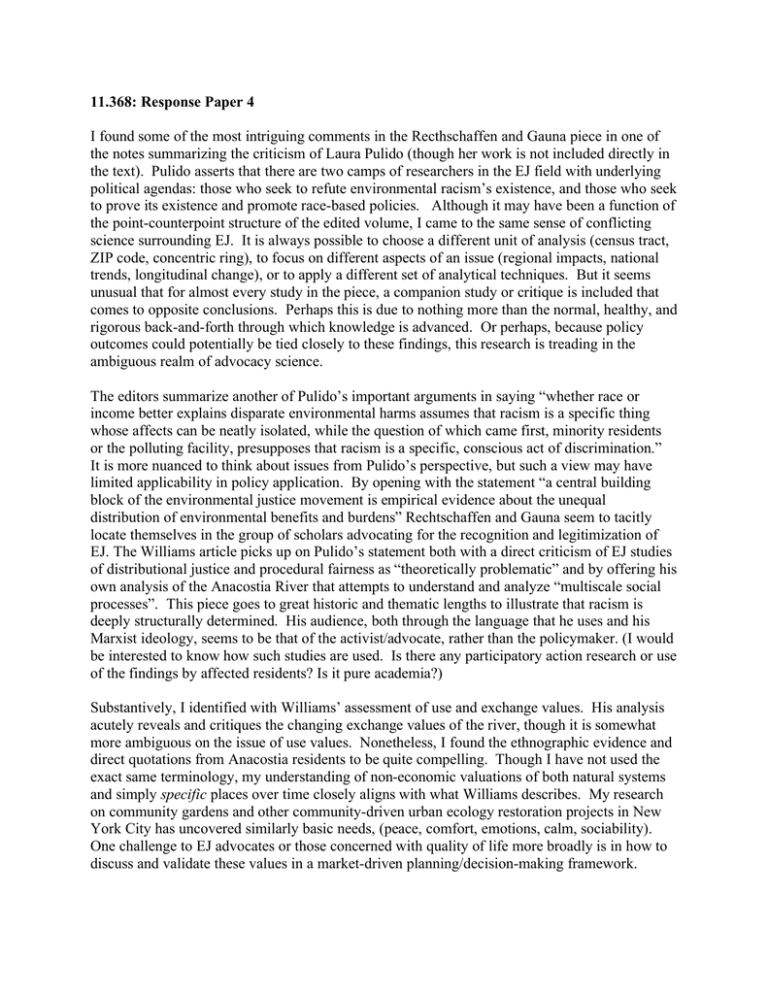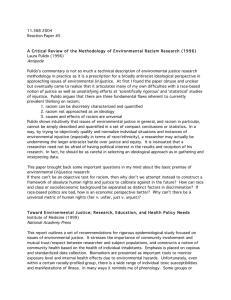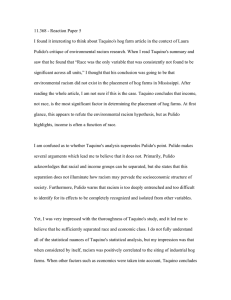11.368: Response Paper 4
advertisement

11.368: Response Paper 4 I found some of the most intriguing comments in the Recthschaffen and Gauna piece in one of the notes summarizing the criticism of Laura Pulido (though her work is not included directly in the text). Pulido asserts that there are two camps of researchers in the EJ field with underlying political agendas: those who seek to refute environmental racism’s existence, and those who seek to prove its existence and promote race-based policies. Although it may have been a function of the point-counterpoint structure of the edited volume, I came to the same sense of conflicting science surrounding EJ. It is always possible to choose a different unit of analysis (census tract, ZIP code, concentric ring), to focus on different aspects of an issue (regional impacts, national trends, longitudinal change), or to apply a different set of analytical techniques. But it seems unusual that for almost every study in the piece, a companion study or critique is included that comes to opposite conclusions. Perhaps this is due to nothing more than the normal, healthy, and rigorous back-and-forth through which knowledge is advanced. Or perhaps, because policy outcomes could potentially be tied closely to these findings, this research is treading in the ambiguous realm of advocacy science. The editors summarize another of Pulido’s important arguments in saying “whether race or income better explains disparate environmental harms assumes that racism is a specific thing whose affects can be neatly isolated, while the question of which came first, minority residents or the polluting facility, presupposes that racism is a specific, conscious act of discrimination.” It is more nuanced to think about issues from Pulido’s perspective, but such a view may have limited applicability in policy application. By opening with the statement “a central building block of the environmental justice movement is empirical evidence about the unequal distribution of environmental benefits and burdens” Rechtschaffen and Gauna seem to tacitly locate themselves in the group of scholars advocating for the recognition and legitimization of EJ. The Williams article picks up on Pulido’s statement both with a direct criticism of EJ studies of distributional justice and procedural fairness as “theoretically problematic” and by offering his own analysis of the Anacostia River that attempts to understand and analyze “multiscale social processes”. This piece goes to great historic and thematic lengths to illustrate that racism is deeply structurally determined. His audience, both through the language that he uses and his Marxist ideology, seems to be that of the activist/advocate, rather than the policymaker. (I would be interested to know how such studies are used. Is there any participatory action research or use of the findings by affected residents? Is it pure academia?) Substantively, I identified with Williams’ assessment of use and exchange values. His analysis acutely reveals and critiques the changing exchange values of the river, though it is somewhat more ambiguous on the issue of use values. Nonetheless, I found the ethnographic evidence and direct quotations from Anacostia residents to be quite compelling. Though I have not used the exact same terminology, my understanding of non-economic valuations of both natural systems and simply specific places over time closely aligns with what Williams describes. My research on community gardens and other community-driven urban ecology restoration projects in New York City has uncovered similarly basic needs, (peace, comfort, emotions, calm, sociability). One challenge to EJ advocates or those concerned with quality of life more broadly is in how to discuss and validate these values in a market-driven planning/decision-making framework.





